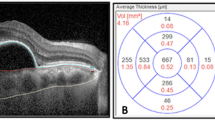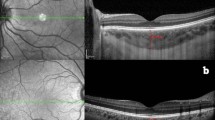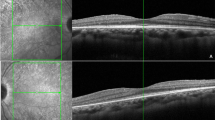Abstract
Purpose
To determine changes in choroidal volume (CV) and choroidal vascularity index (CVI) in patients on hydroxychloroquine (HCQ) therapy.
Methods
Retrospective analysis of patients on HCQ therapy. CV and CVI were assessed below the central foveal region on spectral-domain optical coherence tomography using an automatic denoising and localization algorithm. CV and CVI were compared with age-matched controls. Regression analyses were performed to generate associations between CV and CVI with demographics and HCQ treatment parameters. Associations were assessed using a generalized estimating equation model adjusted for intra-subject inter-eye correlations.
Results
A total of 137 adult patients (23 males and 114 females) were included. Mean age was 45.6 ± 13.7 years and most patients identified as Caucasian (79%). Total duration of HCQ therapy ranged from 3 months to 20 years. Daily HCQ intake varied from 150–600 mg (mean = 304 mg), while cumulative doses ranged from 18–2,800 g. At presentation, the median CV was 0.51 (IQR:0.356–0.747) mm, and median CVI was 0.559 (IQR:0.528–0.578). Increased cumulative HCQ dose was associated with decreased CV (p = 0.006). Compared to age-matched controls, CV, CVI, and luminal area were significantly lower in the study group (p = 0.0003, 0.0001, and 0.0002).
Conclusion
In this study, we present a novel analysis of key biomarkers which predate the occurrence of HCQ retinopathy. Choroidal volume and vascularity index are significantly reduced in patients on HCQ therapy, especially at higher cumulative doses. These findings suggest new tools to guide medical decision-making for patients receiving HCQ therapy for rheumatologic diseases.
This is a preview of subscription content, access via your institution
Access options
Subscribe to this journal
Receive 18 print issues and online access
$259.00 per year
only $14.39 per issue
Buy this article
- Purchase on Springer Link
- Instant access to full article PDF
Prices may be subject to local taxes which are calculated during checkout


Similar content being viewed by others
Data availability
Data are available upon request.
References
Schrezenmeier E, Dörner T. Mechanisms of action of hydroxychloroquine and chloroquine: implications for rheumatology. Nat Rev Rheumatol. 2020;16:155–66.
Yusuf IH, Sharma S, Luqmani R, Downes SM. Hydroxychloroquine retinopathy. Eye. 2017;31:828–45.
Marmor MF, Kellner U, Lai TY, Lyons JS, Mieler WF, American Academy of Ophthalmology. Revised recommendations on screening for chloroquine and hydroxychloroquine retinopathy. Ophthalmology. 2011;118:415–22.
Marmor MF, Hu J. Effect of disease stage on progression of hydroxychloroquine retinopathy. JAMA Ophthalmol. 2014;132:1105–12.
Min CH, Lee JY, Yoon YH. Longitudinal changes in outer nuclear layer and choroidal thickness in patients using hydroxychloroquine before development of retinopathy. Investig Ophthalmol Vis Sci. 2022;63:3786.
Polat OA, Okçu M, Yılmaz M. Hydroxychloroquine treatment alters retinal layers and choroid without apparent toxicity in optical coherence tomography. Photodiagnosis Photodyn Ther. 2022;38:102806.
Cinar E, Yuce B, Aslan F. Evaluation of retinal and choroidal microvascular changes in patients who received hydroxychloroquine by optical coherence tomography angiography. Arq Bras Oftalmol. 2021;84:2–10.
Forte R, Haulani H, Dyrda A, Jürgens I. Swept source optical coherence tomography angiography in patients treated with hydroxychloroquine: correlation with morphological and functional tests. Br J Ophthalmol. 2021;105:1297–301.
Ahn SJ, Ryu SJ, Joung JY, Lee BR. Choroidal thinning associated with hydroxychloroquine retinopathy. Am J Ophthalmol. 2017;183:56–64.
Singh SR, Vupparaboina KK, Goud A, Dansingani KK, Chhablani J. Choroidal imaging biomarkers. Surv Ophthalmol. 2019;64:312–33.
Iovino C, Pellegrini M, Bernabei F, Borrelli E, Sacconi R, Govetto A, et al. Choroidal vascularity index: an in-depth analysis of this novel optical coherence tomography parameter. J Clin Med. 2020;9:595.
Agrawal R, Chhablani J, Tan KA, Shah S, Sarvaiya C, Banker A. Choroidal vascularity index in central serous chorioretinopathy. Retina. 2016;36:1646–51.
StataCorp LP. Stata statistical software: release 16. College Station, TX. 2019.
Rainsford KD, Parke AL, Clifford-Rashotte M, Kean WF. Therapy and pharmacological properties of hydroxychloroquine and chloroquine in treatment of systemic lupus erythematosus, rheumatoid arthritis, and related diseases. Inflammopharmacology. 2015;23:231–69.
Dardenne MU, Nordmann J. Biochemistry of the Eye: Symposium at Tutzing Castle, August 10-13, 1966. Munich: Karger; 1968.
Ahn SJ, Ryu SJ, Lim HW, Lee BR. Toxic effects of hydroxychloroquine on the choroid: evidence from multimodal imaging. Retina. 2019;39:1016–26.
Bulut M, Akıdan M, Gözkaya O, Erol MK, Cengiz A, Çay HF. Optical coherence tomography angiography for screening of hydroxychloroquine-induced retinal alterations. Graefes Arch Clin Exp Ophthalmol. 2018;256:2075–81.
Iqbal M, Wong WT, Chew EY, Cukras CA. Comparison of choroidal and retinal thicknesses in patients with and without hydroxychloroquine toxicity. Investig Ophthalmol Vis Sci. 2019;60:5715.
Yılmaz H, Akıncıoğlu D, Kucukevcilioglu M, Özge G, Durukan A, Mutlu F. Choroidal thickness in patients using hydroxychloroquine without retinal toxicity. Hitit Med J. 2020;2:73–8.
Karti O, Ayhan Z, Zengin MO, Kaya M, Kusbeci T. Choroidal thickness changes in rheumatoid arthritis and the effects of short-term hydroxychloroquine treatment. Ocul Immunol Inflamm. 2018;26:770–5.
Duru N, Altinkaynak H, Erten Ş, Can ME, Duru Z, Uğurlu FG, et al. Thinning of choroidal thickness in patients with rheumatoid arthritis unrelated to disease activity. Ocul Immunol Inflamm. 2016;24:246–53.
Ferreira CS, Beato J, Falcão MS, Brandão E, Falcão-Reis F, Carneiro ÂM. Choroidal thickness in multisystemic autoimmune diseases without ophthalmologic manifestations. Retina. 2017;37:529–35.
Braga J, Rothwell R, Oliveira M, Rodrigues D, Fonseca S, Varandas R, et al. Choroid thickness profile in patients with lupus nephritis. Lupus. 2019;28:475–82.
Funding
MA-S: protected research time granted by the University of Zurich,234 Career development program filling the gap.
Author information
Authors and Affiliations
Contributions
All authors contributed to the study conception and design. Image analysis: MD/ARM. Data analysis: NH. Writing—original draft preparation: NH/MD. Writing—review and editing: MD/JC/MA-S/DB.
Corresponding author
Ethics declarations
Competing interests
The authors declare no competing interests.
Ethical approval
Study approved by the Institutional review board of Swiss ethics/BASEC 240 (No. 2019-00972).
Additional information
Publisher’s note Springer Nature remains neutral with regard to jurisdictional claims in published maps and institutional affiliations.
Rights and permissions
Springer Nature or its licensor (e.g. a society or other partner) holds exclusive rights to this article under a publishing agreement with the author(s) or other rightsholder(s); author self-archiving of the accepted manuscript version of this article is solely governed by the terms of such publishing agreement and applicable law.
About this article
Cite this article
Hasan, N., Driban, M., Mohammed, A.R. et al. Effects of hydroxychloroquine therapy on choroidal volume and choroidal vascularity index. Eye 38, 620–624 (2024). https://doi.org/10.1038/s41433-023-02747-x
Received:
Revised:
Accepted:
Published:
Issue Date:
DOI: https://doi.org/10.1038/s41433-023-02747-x



